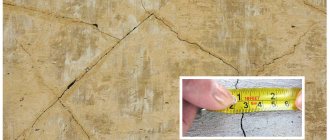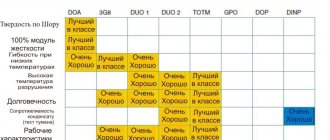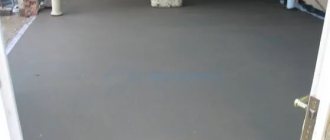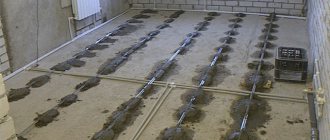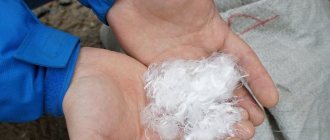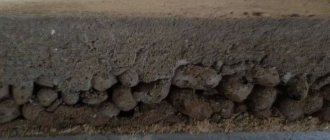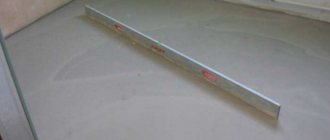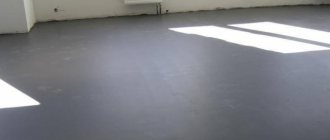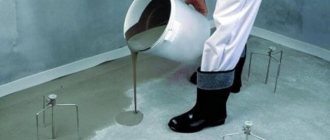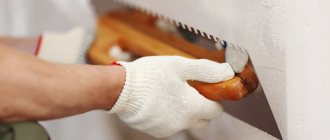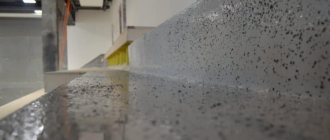Floor screed is the layer between the base and the finishing coating. The higher its quality, the longer the floor covering will last. Some consider this to be menial work that does not require special knowledge, but this is not entirely true. Economy, haste, or basic ignorance of physics can contribute to surface cracking.
Types of damage
Before starting floor screed repairs, it is necessary to determine the type of damage.
This can be done by removing the floor covering. A visual assessment of defects will help identify the specific type of damage, which will allow you to quickly select the necessary means and begin repairs. The main types of damage include:
- detachment of the screed (in whole or in part) from the base of the floor;
- unevenness, potholes, cracks and holes on the surface;
- excessive dust formation, which means weakening of the screed material.
The reasons for the appearance of defects can be very diverse.
It is necessary to pay special attention to them in order to avoid similar mistakes and further destruction of the screed in the future.
The most common reasons are:
- Violation of mixing technology. Most often this happens when using a ready-made mixture. It is recommended to strictly follow the manufacturer's instructions, as incorrect proportions will lead to deterioration in the quality of the mixture. Also, you should not mix the solution by hand - for this purpose it is better to use a special attachment on an electric drill or a construction mixer so that the existing substances are mixed evenly.
- Fast drying. When working with concrete, you should always remember that its durability and strength directly depend on contact with water. The cement floor should not dry too quickly; periodically it should be sprinkled with a small amount of water and covered with polyethylene so that the top layer does not become dry before the concrete has completely hardened.
- Excessive amount of water in solution. Excess water in the concrete mixture, firstly, deforms the concrete itself and reduces the strength of the screed. Too much water eventually causes the screed to crack and the surface to become loose. To avoid this, after the concrete has dried, the screed must be covered with deep penetration soil, which will entail new costs and increase the repair period.
No expansion joints. Incorrectly laid expansion joints or their complete absence most often cause the surface to crack. It is recommended to fill the wall seam with an elastic material like polypropylene foam. It is located along the thickness of the screed, and this reduces the influence of the wall load on it. Intermediate seams divide the screed into equal parts, running along half of its thickness.
No damper tape
It is especially important to have an edge tape when pouring screed for heated floors. Concrete tends to expand when heated, thereby creating additional pressure on the walls
Thus, the absence of a pressure-compensating tape can cause the destruction of not only the screed, but also the walls themselves.
Poor quality reinforcement. The main rule when installing reinforcement is its location in the concrete, and not under the screed.
There are many other factors that lead to the destruction of the screed. Most often, this is poor quality of the solution, low-quality cement mixture used in construction, or violation of the pouring stages. Detachment of the screed can be caused by local impact loads or improper preparation of the surface for pouring concrete.
We remove large cracks
Larger potholes larger than 2 cm in size can be removed as follows:
- Deepen the crack to 5 cm using a grinder.
- Using a chisel, make a groove on both sides of the crack and remove all the concrete.
- Coat the dust-free surface with epoxy.
- Fill the crack with concrete mortar in several stages.
- If the damage is too large, then first make several cuts 2 cm deep and 1.5 cm wide across the crack. After this, fill the resulting grooves with concrete and secure them with metal staples.
- Clean and sand the surface after the mortar has hardened.
Healthy! If no one lives in the room yet, you can check the cracks for subsequent deformation. Place regular sheets of paper over the grooves (so that it stretches) and wait a few days. If the paper is cracked, even if you repair the crack, it will still appear again over time.
Causes of cracks in screed
Cracks usually appear in areas of stress concentration. Next, we will consider in detail each cause of cracks in the screed.
Weak, low-rigid base
The concrete from which the screed is made can withstand high compressive loads. When using grade 300 cement, the strength exceeds 300 kgf/cm2. But the bending and tensile strength is tens of times less and depends on the design of the screed, the shape and number of expansion joints, the composition of the concrete and the reinforcing mesh.
Deviation from the recommended GOST and SNiP (collection of building codes and regulations adopted in the Russian Federation) technologies reduces the strength of concrete. If the base of the screed is movable, for example, an old worn-out wooden floor, or is insulated with polystyrene foam that is not suitable for its hardness, the concrete will become covered with cracks because it does not tolerate bending loads well. The answer to the question why the floor screed cracks lies in calculation errors or violations of the floor construction technology.
Incorrectly arranged expansion joints
Concrete has a rigid structure, so the absence or incorrect calculation of seams leads to the appearance of cracks. When the temperature in a room changes, the concrete heats up unevenly, so different areas are affected by different thermal expansion. These processes cause stress in the concrete, because the more heated material expands, while the less heated one remains the same size.
Expansion joints help relieve stress. They divide the screed into sections of 2-6 square meters. In such an area under room conditions, the temperature differences in the concrete are not sufficient to damage the screed and cause cracks in the floor. The screed is also fenced around the perimeter with a damper tape, which provides a thermal gap between the concrete and the walls of the room. Failure to comply with temperature gaps will destroy the screed due to temperature changes.
Excess or lack of water in solution
Concrete is an aqueous solution of cement, sand and crushed stone. The amount of water affects the mobility of the mixture. Thick mortar does not fill voids well and adheres to the base. The liquid solution fits well on the base, but when it hardens, it becomes covered with cracks. Such concrete has less strength than necessary, so during the operation of the floor, cracks will increase and deepen.
For each type of concrete work, including screed, the amount of water for concrete is determined individually. For pouring onto a flat concrete base, a thicker solution is used; for an uneven base, a thinner one is used. This issue is covered in more detail in GOST 7473-94.
Small layer thickness and weak reinforcement
The greater the thickness of the screed, the higher the fracture resistance. Therefore, in screeds less than 3 cm thick, made from ordinary concrete, and not self-leveling mixtures, cracks appear 2-3 times more often than in thicker ones. Pouring such a screed onto an old wooden floor will lead to cracks appearing after 3-5 months of use. To prevent cracks from appearing, pour self-leveling screeds and self-leveling floors onto wooden floors. These materials withstand fracture forces better, so cracks appear less frequently.
When pouring the screed in a warm, dry, ventilated room, moisten it every half hour for 10-12 hours. Excessively rapid evaporation of water from concrete will lead to the fact that the bottom of the screed, full of water, will shrink less than the top blown by ventilation. This will lead to tension in the concrete, which will form cracks. As the floor is used, the cracks will increase and deepen.
Causes of crack formation
First of all, to prevent cracks from plaguing the operation of heated concrete screeds, it is necessary to understand where the threat may lie:
- The problem is in the foundation. The key floor can be too thin and heterogeneous.
- Poor quality of concrete screed
. The percentage of cement and other elements does not meet the strength requirements or other factors for good installation are not met.
If the basis for everything is the installation of the heating circuit and the final screed, then the situation can be improved only by dismantling the top concrete screed.
Main! It is necessary to equip a heated floor only on a basis whose strength is beyond doubt. If the key floor is of poor quality, then there is no point in making a thick layer of screed over it.
In case the problem is in the screed itself, cracks that appear on the surface can be repaired more easily. However, before considering sealing methods, it is necessary to keep in mind what will cause these cracks to appear.
There are no damper tapes or expansion joints
It is common for a cement screed to shrink during the drying period. If shrinkage occurs unevenly, with varying degrees of load on unequal areas, then the formation of cracks, small and large, will not be long in coming. The basis for incorrect shrinkage can be:
- Uneven screed thickness.
- Different temperature indicators in a wide variety of areas of the coating.
- The action of other structural elements of the building. For example, cement dries faster near a door, undergoing tension from adjacent rooms. Under such a load, the screed
breaks. Such cracks can be covered with facing mixtures. But all this can be eliminated if expansion joints are used.
How are expansion joints made? They are left in the most stressful areas (next to walls, near door openings). They are intended to isolate the cement setting process in adjacent rooms.
Also, the use of damper tape is necessary to protect the walls from the screed itself. Under the influence of temperature, it can increase, and then damage will be caused to both the wall and the screed itself.
Application of damper tape first
If the room has large areas, then expansion joints can be made in small sections of 4–5 meters. For example, it is allowed to make seams in areas where two floors are connected. Seams can be made directly after the screed has been poured, cutting with an angle grinder to a depth of 1/3 of the thickness of the screed.
Violation of solution proportions
It is necessary to follow the requirements for the ratio of water and dry mixture. However, very often inexperienced installers can make an error to make it easier to apply the solution.
Mixer for preparing solution
Too much of a solution in liquid form will be fragile, so it is necessary to accurately follow the proportions set by the manufacturer. The manufacturer himself accurately determines the percentage of water and mixture.
It is also very important that the solution is mixed thoroughly. You cannot do these steps manually, you need to use a specialized mixer
Incorrect layer thickness
The thickness of the layer is also especially important for the strength of the coating
The layer can be either very thin or very thick:
- with a thin layer, the reliability will be unsatisfactory, and the coating will most likely not withstand the load;
- with a large layer, humidity will cause deformation due to increased resistance of the material.
Violation of the solidification process
You need to know one of the basic principles of the strength of a cement-based screed: the longer the moisture is retained, the stronger the screed will be. Accelerating hardening will only cause the opposite effect, leading to poor strength. This will cause cracks to form.
Due to this, it is necessary not only to protect from drafts and sunlight, but also just not to turn on the system so that it does not heat up the concrete.
How to repair cracks?
The types of deformation described above lead to the screed starting to crack. This is bad because over time, even the smallest recesses expand, and because of them, major repairs of the floor will have to be done. Cracks are one of the most severe types of destruction, requiring emergency removal, so they must be eliminated in a timely manner. Cracks can be small or deep.
Small-diameter cracks are considered to be damage up to 2 mm wide.
You can repair the screed yourself as follows:
Use a grinder to widen and deepen the crack
Particular attention should be paid to the fact that after expansion, the edges of the crack should not crumble, but should be absolutely solid. If you can’t use a grinder, you need to stock up on a hammer and chisel. After expansion, the cracks need to be cleaned
Only a construction vacuum cleaner is used for this purpose. The cleaned areas are coated with epoxy primer. This must be done several times until the mixture is completely absorbed into the concrete. After the primer has completely dried, the damaged areas are filled with a mixture of Rizopox 3500 and quartz sand. The mixture should fill the crack just above the surface level. After the mixture has hardened, the repaired areas are sanded and cleaned.
Repairing minor damage takes little time and allows you to do without special tools.
If large cracks have formed in the screed - more than 2 mm in width - the repair process will proceed according to the following scheme:
- As in the first case, the cracks must be cut to their full depth.
- After expanding the crack across it, it is necessary to make several grooves.
- Small repair seams (1.5 cm long) are made along the grooves at intervals of 2 cm.
- The prepared recesses should be cleaned using a construction vacuum cleaner, treated with a primer and left to dry.
- After the primer has dried, the repair joints will need to be filled with pieces of reinforcement, metal staples or wire.
- Next, the cavities are filled with liquid mortar made from a mixture of sand and cement. The surface is leveled with a lath and sanded after drying.
Reinforcing the screed helps protect it from stress and extends its service life. There is also a little trick that will help you find out whether the cracks are expanding over time or not. To do this, you need to glue a paper strip to the edges; if it breaks after a while, then the forecasts are disappointing. If the piece of paper remains the same as it was, then everything is in order. But this method requires a lot of time.
Removing small cracks
Microcracks with a diameter of less than 15 mm are expanded with a chisel and a hammer to a depth of 1 cm. As a result, you should end up with a kind of groove that will narrow at the bottom.
The resulting cracks must be cleaned using a vacuum cleaner or sandblaster and treated with “epoxy” and solvent, which are mixed in a ratio of 1:10. You can also use tile adhesive.
After the surface has dried, the groove is filled with mortar, cleaned and sanded.
Causes of cracks in floor screed
There may be several reasons, but let’s start with the solution in order – by preparing the solution.
Poorly prepared solution
For cement preparation, the so-called “hard mortar” of grade 100 - 200 is used. The preparation of the mortar for the screed is carried out in compliance with the proportions of ingredients prescribed by SNiP standards - sand, cement, water. Sand should be used washed with large or medium grain size. The presence of clay inclusions in sand can cause cracks in the screed.
The brand of cement and its quantity determine the brand of mortar composition. The consumption of components for preparing 1 m3 of solution can be found in the article thickness of the screed, as well as the requirements for it.
Caring for cement screed
The screed is covered with plastic film
Proper care of its surface after installation is of great importance when installing a coating. To avoid cracking, curing must take place under moisture conditions to prevent cracks from occurring and therefore avoid sealing cracks in the floor screed.
To do this, there are a number of measures, such as moistening the screed, starting from the second day of its installation, filling it with a layer of wet sawdust, which is kept moist for a week, you can cover the wet surface with plastic film to prevent moisture evaporation and other measures.
The thickness of the screed does not correspond to the design
The thickness of the preparation is provided for by the design in each specific case, but sometimes it is carried out in violation of the design. A layer that is too thin, for example, 20 mm, if there is an increased load on it, can lead to cracking of the base.
This is especially pronounced if the preparation is made over a layer of waterproofing or insulation (for example, polystyrene foam boards). In this case, there is no high-quality adhesion to the base of the floor.
From personal experience I can say that the most optimal thickness of a floor screed, at which sufficient strength is achieved, is 35 - 45 mm. With these parameters, cracking is least likely and, accordingly, there will be no need to seal cracks in the floor screed.
Floor screed without damper tape
Despite the fact that the temperature regime in the room is generally constant, processes of temperature compression and expansion also occur here. This is especially true during weather temperature changes at the junction of preparation and external wall structures.
For example, if thermal expansion of the external walls occurs, they will put pressure on the screed. This will cause cracks to appear. Therefore, a gap (at least 10 mm) is left between the preparation and the surface of walls, partitions, columns, into which a damper tape is laid around the perimeter.
Damper tape
The damper tape serves as a kind of “compensator” for thermal compression and tension. This event is sufficient for small areas.
For large room sizes and appropriate instructions in the design, in order to extinguish the processes of compression and tension and not cause the formation of cracking of the surface, expansion (expansion) joints are formed.
In it, seams are cut to a depth of 2/3 of the thickness of the preparation layer a day after the installation. On large areas, not single seams are made, but the entire area is cut into squares with a step of 6 meters. There may be several such cards.
Reasons for the appearance of defects on the screed
Design of heated floors general recommendations
The materials from which houses are built and continue to be built change over time. Almost every new resident is faced with the concept of “house shrinkage.”
But since it is impossible to influence them, it is worth learning about those that we can prevent. These include:
- errors in preparing the mixture and screeding device,
- laying the screed on the insulating layer,
- no expansion joints or edge tape.
Thermal or waterproofing can cause cracks to appear, since in this case there is no natural adhesion between the base and the screed.
The screed is poured onto surfaces of different geometric shapes and areas. Therefore, expansion and hardening occur unevenly, which can lead to cracking.
To prevent this from happening, expansion joints are used. Large areas may require not even single cuts, but an entire mesh with a step of about 5 meters. The cuts are made with a grinder to a depth of approximately one third of the poured layer. The damper tape allows you to avoid the harsh mutual pressure of the mass of concrete and walls.
Methods for repairing cracks in screed
Repairing cracks in the floor screed will depend on the reasons that caused them to appear.
Expansion seams
So, we’ll tell you how to repair cracks in the screed due to the lack of seams.
The repair includes the following stages:
- In the screed you need to cut a mesh of expansion joints in increments of 5 m and a depth of 1/3 of the coating thickness.
- The resulting holes should be sealed with polyurethane sealant. In this case, it is worth taking into account the strength of the coating, which should match the parameters of the sealant. Otherwise, either the soft sealant will burst from pressure, or the screed will crumble due to too hard seams.
- The cracks themselves need to be slightly widened using the strobing method.
- After this, the surface of the groove must be cleaned of dust and primed.
- If you are puzzled about how to repair cracks in the floor screed, then there is a special non-shrinking substance on sale. It is applied with a spatula very carefully.
- The final stage will be to grout the cracks to the level of the general surface.
Other technology violations
If, due to an incorrectly prepared solution, a violation of the thickness of the coating or uneven hardening, the floor screed is cracked - what to do can only be decided after the scale of the damage has been assessed
In addition, it is important to consider how such a subfloor will be used in the future.
For example, if tiles are laid as a finishing coating, and the extent of the damage is insignificant and is not in a visible place, they can be neglected. In this case, the tile adhesive will serve as a binder, and the tile itself will prevent unnecessary external loads. And replacing tiles is not difficult and does not require redoing the entire masonry.
The situation looks somewhat different if the room is large and the floor is under significant load. When, due to a very thin layer of fill or excess liquid in the solution, it turns out that the screed is cracked, quite often it has to be completely redone.
If the deviations from the norm are insignificant, but the screed is still cracked, we have already described what to do above.
If you want to prepare a solution for filling cracks in the floor yourself, a mixture of the following ingredients is quite suitable:
The ratio of glue and cement is one to two. You need to add enough water so that the mixture is liquid, but does not spread. It is necessary to pour the mixture into the gap above the floor level, since it will shrink as it dries. Once everything is dry, excess cement can be removed with a grinder.
With the help of our photos and video materials, you can understand how to repair cracks in the floor screed, if any arise. However, it should be remembered that it is much easier to prevent a problem than to eliminate the consequences later.
Is the crack expanding?
The cement mixture itself is very susceptible to defects. In this case, it is very important to find out not only the reason for their formation, but also the dynamics of the increase in cracks in the screed. This practice especially applies to apartments in which the interfloor floors are not particularly rigid. How can you tell if there is a tendency for a crack in the foundation to grow larger?
When checking the coating for the possibility of further deformation, you need to do the following:
- Stick a strip of paper over the crack;
- Do not touch the pasted area for a month;
- If the paper breaks after a specified period of time, we can talk about a tendency for the size of the crack to increase.
What to do in this case? Often, such problems arise when renovating an apartment yourself. Why? Failure to follow the rules for mixing and laying concrete mortar inevitably leads to damage to the material.
To correct the situation, it is advisable to seek help from specialists. Of course, the price for restoring a subfloor can be quite high. But in this case you can be sure of the quality of the work done.
The main causes of screed cracking
A cracked screed can be the result of even professional floor filling, since defects can appear after dismantling the guides (beacons) or for a number of the following reasons.
Incorrect proportion of kneading components
Most often, this problem arises precisely because of ready-made concrete mixtures that are sold in the store. The fact is that during the production of such compositions the exact ratio of components and water added to them is calculated. But every novice builder knows that the easiest way is to apply a liquid solution to the surface, which is why many do not follow the strict proportions specified in the instructions.
An excess of water in the solution leads to shrinkage and deformation of the concrete, which in turn causes a cracked screed.
No expansion joints
If the area of the room is more than 30 m2, then it is necessary to make expansion joints, which are filled with polyurethane foam (if we are talking about outdoor areas, the joints are filled with silicone). Thanks to them, it is possible to significantly reduce the load from the walls. The absence of such seams in large rooms leads to deformation of the screed.
Incorrect reinforcement
Speaking about why floor screed cracks, it is worth paying attention to a fairly common mistake - poor-quality reinforcement. The fact is that some novice builders lay a reinforcing layer under a heavy concrete base, at a time when the reinforcement should be placed precisely in the “body” of the screed
In addition, it is worth considering that the use of reinforcing mesh does not allow achieving the best effect, so experts recommend using cheaper fiber fiber, which is added directly to the cement-sand mortar.
In addition to the main mistakes, in the process of making and drying a concrete base, a lot of other mistakes are made that lead to no less serious consequences.
How to strengthen a screed from cracking
If you want to avoid problems and not have to resort to repair work with the screed in the future, you just need to follow the technology for laying it.
Quality primarily depends on the proportions of the composition. If there is excess water or cement, cracks are guaranteed to form. The quality of the foundation is also important. If its surface is unreliable or strongly absorbs moisture, the screed must be reinforced
Another important point is the drying of the solution. Most people try to speed up this process and start creating drafts or heating the room. Because of this, uneven and too rapid evaporation of moisture occurs, which also leads to cracking. The sand-cement mortar should dry gradually at normal temperature and humidity, in addition, in windy and hot weather they should be moistened and protected from drying out too quickly. For this, as a rule, damp burlap is used.
Floor coverings
- Laminate
- Warm floor
- Linoleum
- Tile
- Carpet
- Parquet
- Self-leveling floor
- Wooden floor
Floor construction
- Skirting
- Floor screed
- Leveling the floor
- Sound and waterproofing
- Insulation of floors
- Concrete floors
- Floor repair
- Substrate
Calculation of laminate boards Calculation of paving slabs
Tell us about us
PolGuide 2012-2019 | Information
When copying materials active link to the site is required
Causes of cracks
Most often, cracks and defects occur when the screed pouring technology is violated
There are often cases where even experienced builders have to throw up their hands, since all the work was carried out in accordance with building codes, but the result was negative (the floor screed was cracked).
This shouldn’t happen; it means that some small nuances were not taken into account, which, as it turned out, are of great importance. Therefore, you should carefully and efficiently carry out the work on constructing the concrete cover and select the appropriate material so that cracks do not appear in the floor screed.
Reinforcement is an important part of the concrete foundation
Today, there are a number of things that can lead to cracking of the floor:
- Lack of reinforcement in the flooring. When making a cement-sand screed using additional materials that enhance the heat-insulating and sound-proof properties of the room as a whole (expanded clay and expanded polystyrene flooring), it is necessary to make additional reinforcement (metal and fiberglass rods, steel mesh). If this process is neglected, there is a possibility that the floor may crack.
- Displaying beacons using a different solution. When forming the floor, you must remember that it is not always worth fixing the beacons with alabaster or gypsum mortar, since the incompatibility of the solutions “can play a cruel joke.” Materials have different indicators of moisture conductivity.
- Incorrect solution.
The main drawback in the formation of the solution is considered to be an excessive amount of water. After the moisture dries, cracks often appear in the screed in the places where it was released. Damper tape softens the impact of concrete on walls - Inappropriate screed thickness. Such a violation often leads to cracks in the heated floor screed. It is with the introduction of this modern heating device that the thickness of the screed, which should be 3-4 cm, is not observed.
- The absence of a damper tape around the entire perimeter of the room leads to cracking of the screed near the walls.
Since the coatings may not interact, and an air gap will form between them, which can lead to cracking of the screed.
Why does the screed crack after drying?
The thickness of the screed must be at least 3 cm
Quite often it happens that the screed cracks during drying. Many builders, having created the flooring, believe that the job is already completed and cease to control the drying process of the concrete cover, which cannot be done.
Also, before creating a floor, it is necessary to thoroughly calculate the load. To do this, you need to know how much traffic there will be in the room, and whether massive and heavy objects will be placed.
Cover the drying surface with film
You should know what can cause cracks to form on a drying concrete floor:
- Violation of temperature and humidity when drying the flooring. There are certain rules for drying the screed, according to which the process must take place at an ambient temperature from +150C to +250C; if the indicators are exceeded, then there is a need for additional watering of the cover laid on the ground (within 20 days).
- Covering with polyethylene. When filling the screed in the summer, after watering it with water, the entire area of the flooring should be covered with plastic film. This process is done to prevent moisture from evaporating.
- Movement on the ceiling during hardening is not allowed. The laid screed should not be loaded; only on the 3-4th day can wooden platforms and boards, preferably 1 cm thick, be laid down.
- Limitation of ventilation in the room. To prevent builders from having to repair cracks in the screed, after pouring it in the room, it is necessary to close all windows and limit the air flow.
- House shrinkage. Construction professionals strongly recommend that in a new private house (even with a well-established foundation) the floors should be poured no earlier than six months, and preferably 11-12 months. So that you don’t have to repair the screed and seal cracks that form as a result of subsidence of the house.
After watering the screed and covering it with film (3 days after installation), wet sawdust or sand should be poured on top, which will prevent moisture from escaping. The screed should remain in this condition for 11-14 days. To learn how to make a beacon screed, watch this video:
Causes of cracks in screeds when drying
Cracks in fresh screed
To prevent cracks in the cement screed, it is necessary to dry it properly.
Before making a layer, you need to determine the load on the floor and select the appropriate brand of cement.
If heavy equipment or furniture is expected to be installed on the floor, then the grade of cement for preparation should be taken higher.
The screed must be poured in compliance with all requirements and rules.
Why the floor screed cracks when drying can be found out by studying some of the recommendations necessary for use when drying the screed:
- Violation of humidity and temperature conditions. The recommended temperature for normal drying of the screed is +15-25 degrees. If the temperature is more than +25 degrees, the floor should be watered until it is completely hardened - 28 days.
- Polyethylene coating. After the cement screed has been doused with water to maintain moisture, it should be covered with plastic film.
- You cannot walk on the screed. You can walk on a cement screed only on the third day; for this you need to lay boards and move strictly on them. You cannot put building materials on it or load it in any way.
- Limit ventilation. For normal drying, immediately after the solution is applied, it is necessary to close the windows and doors in the room to prevent drafts that contribute to the formation of cracks.
- House shrinkage. New houses always shrink, so cracks may form on the new screed after drying. The shrinkage process can last up to one year.
In order not to water the screed every day, you can, after watering it and covering it with film, cover the surface with wet sawdust or sand to better retain moisture. This is done 3 days after pouring, when all the beacons are removed and the holes after them are sealed. The screed must remain under the polyethylene for at least two weeks.
Cement-sand screed practically does not shrink, therefore, if all the rules for pouring the floor have been followed, cracks should not appear on it. This surface is durable and does not require additional care.
How to repair cracks in a floor screed?
Elimination of minor defects
Small cracks for repair are opened with a hammer and chisel
Restoring a screed with your own hands if there are small cracks is quite easy; for this you need:
- Using an angle grinder with a diamond disc, slightly widen the crevice;
- Remove loose pieces of concrete along the edge of the crack;
- Prime the resulting cracks;
- Fill the cracks with tile adhesive.
Renovating an apartment involves some difficulties that are worth mentioning. If the concrete surface is cracked in the bathroom, it is impossible to repair the defects with ordinary tile adhesive. In just a couple of months it will peel off due to high humidity in the room.
If the microclimate in the room is specific, a mixture with water-repellent properties should be used to fill the defects. You can see how to repair a screed in a bathroom in the video below.
Elimination of large cracks
Repairing an old screed with large cracks in the technique differs little from the previous version. And yet, in this case, a mixture of cement and epoxy is used to fill the cracks. Large-area defects cannot be sealed with tile adhesive due to the low adhesion of the adhesive solution. What to do if the screed is cracked?
- First, the crevice needs to be grooved;
- It is desirable that the crack has a smooth edge on both sides;
- The resulting dust is removed with a vacuum cleaner so that the adhesive mixture has good adhesion to the concrete;
- After this, several deep cuts must be made across the gap to reduce the load on the seams;
- Then the prepared areas of the coating are primed;
- At the final stage of repair, a mixture based on epoxy resin is applied.
Conclusion
What should you do if the screed is cracked? The first step is to determine the nature and extent of damage, as well as the causes of their occurrence. Depending on the size of the defects, tile adhesive, mixtures based on epoxy resin or cement mortars, the price of which is quite reasonable, are used to eliminate them.
Recommendations for floor repairs
An example of expansion joints to prevent cracking
Repairing a floor screed is a responsible undertaking that requires strict adherence to the rules for restoring old and freshly poured screeds. To repair the base without any problems, before performing the procedure you should pay attention to the following nuances:
- First you need to find out exactly the reason for the formation of flaws;
- Check whether there are expansion joints on the coating;
- Find out how the cement mixture was poured, what base the solution was laid on (concrete, wood);
- If there are no expansion joints on the floor, before repairing cracks and potholes, it is advisable to take care of laying them;
- To determine whether local delamination of concrete is present, it is advisable to tap the coating with a rubber hammer.
If you ignore all of the above recommendations, within a couple of months potholes, dents and “boiling” concrete will again appear on the base.
We determine the nature of cracks and the reasons for their appearance
At this stage it is important to determine the nature of the cracks. If they are small, that’s one thing, and the reason is more likely to be the quality of the mixture or improper care after pouring (here protection from rapid drying is necessary: the screed is covered with a film and wetted with water every 1-3 days), such cracks are practically not dangerous and can be easily sealed with liquid mortar
Also, such cracks can appear at the joints of the screed with beacons or at the junction of an already dried part with a new one.
Another option is cracks to the base (floor or insulation). Here you need to take the issue more seriously and seal the cracks with epoxy. If there are a lot of cracks, about 50% of the area is cracked, it is better to dismantle the screed and lay it again (which is sometimes not possible), following the recommendations for the device (reinforcement, maintenance, etc., this is discussed at the end of the article).
Small cracks, not to the base, not particularly scary
Coiling screed
A cracked screed may buckle, that is, vibrate under shock load. This is possible when laying on sand or polystyrene foam. If you have a piece of screed that is buckling, then it is best to seal the crack with epoxy resin. You can leave such a screed only if you are planning repairs for 10-15 years, no more. Perhaps it will need to be changed later, or maybe not - depending on your luck.
The vibrating screed must be strengthened
Do cracks need to be sealed?
An important question: is it necessary to repair cracks in the screed at all? Well, in general, the screed cracks “all the time” (that is, quite often) and there shouldn’t be any special problems with cracks.
I recommend: How to determine the permissible load on a floor slab
How do you know if it needs to be sealed? Try jumping along the edges of the crack or tapping it with a rubber mallet. If the screed vibrates strongly (often happens when laid on a soft base), then you should take care of sealing the cracks, preferably with epoxy. If no dust comes out of the crack during impacts and the screed does not vibrate (that is, most likely it is laid on a solid base), then you can seal the crack with a liquid solution.
Small cracks in the screed can be repaired simply with mortar
When laying tiles, small cracks (not all the way to the base) can be sealed directly with glue.
There are a lot of situations in which a screed cracks, and only a specialist can decide whether the crack really needs to be repaired or can be left as is. The article describes many situations, but the technological aspect is not the only one. There may be deadlines, circumstances, and so on... The main thing is to do it conscientiously, so that there are no problems later.
#Promised bonus: Calculation of solution for self-filling screed
If you plan to independently prepare a solution for pouring screed, then all responsibility for the correct dosage of components, that is, for the quality of the future concrete, rests entirely with the master himself. To avoid making mistakes, use our online calculator.
Explanations for calculations
The calculator will calculate, firstly, the total amount of solution required to fill the entire room.
- To do this, of course, you should indicate the area of the room.
— The difference in the base level is indicated (the difference between the highest and lowest points). That is, the unevenness (distortion) that will be eliminated with a screed.
— Finally, the minimum planned thickness of the screed is indicated.
— When planning, it is customary to include a supply of construction materials. In our calculator, the user can choose to leave a “net” result or take into account a reserve of 5 or 10 percent.
Secondly, it is possible to carry out calculations taking into account the capacity of the existing concrete mixer (which should be indicated in the calculator).
The program will calculate both the number of batches and the “recipe” for each batch.
This means that the user will be shown how much cement, sand, water and plasticizer is required for one batch. Moreover, it is shown in units of measurement convenient for practical work - liters and buckets.
We repair coiled areas
Heaving areas are areas of the concrete foundation that begin to move under load. To repair this type of damage:
- Remove the coating to a stable surface and check for cracks.
- Remove loose concrete, clean the slab and coat it with primer.
- Fill the resulting cracks with building mixture and let it dry.
You can also repair damaged areas using concrete injection. For this:
- About the plots.
- Using a hammer drill, drill holes in them 7-10 mm wide and up to 25 mm deep.
- Using a construction syringe filled with epoxy, fill the holes (do not fill to the brim immediately).
- Wait until the resin hardens and go over the holes again with a syringe.
- Repeat the procedure until the epoxy level stops decreasing.
- Wait a day, during which it is not recommended to walk on the surface.
After completing the repair work, it is better to strengthen the base so that the floor screed does not crack again.
Cracks in the screed. Repairing cracks in screed
As mentioned above, cracks in the screed may appear if the floor is filled with liquid mortar in very hot weather. If cracks in the screed occur on an already used floor, then there may be much more reasons for the appearance of cracks. The most common reasons that can cause cracks in the screed on an already working floor base.
What can cause cracks in the floor screed?
Do not use small crushed stone when pouring the screed. Crushed stone is used when pouring floor screed not only as a filler. It perfectly serves as a reinforcing material that prevents the floor screed from cracking and collapsing during use.
The technology for producing cement mortar for screed was violated
Often, in order to save money, many people try to save on such an important material in floor screeding as cement. As a result, the floor screed turns out to be insufficiently strong, loose, and as a result, cracks may form on it
Therefore, in order to avoid the appearance of cracks in the screed, you should not skimp on the main components of the cement mortar. Cracks on the floor can easily occur due to the lack of waterproofing.
How to repair cracks in a screed with your own hands
The formation of cracks in the screed may be due to high load on the floor screed. If during the process of pouring the floor, the thickness of the screed was not maintained, and it turned out to be too small in the end, then cracks on the floor screed will appear in any case.
Cracks in the floor can also appear due to heating and water supply pipes being laid in the floor. Putting Merilon (insulation) on heating pipes hidden in the floor screed can lead to the appearance of cracks in the end. However, we should immediately make a reservation and say that cracks in the floor screed in this case can only appear if the thickness of the cement layer is insufficient.
If it is necessary to repair floor cracks after recently pouring mortar, this must be done as quickly as possible. To do this, liquid cement mortar is diluted, which ultimately fills the cracks in the screed. After this, it is advisable to additionally iron the cement floor, thereby adding some strength to it.
Solution for sealing cracks in floor screed
If it is necessary to eliminate cracks in the screed on a ready-made concrete floor, then it is better to pour a thin layer of cement mortar on top of the cracks in the screed.
To be on the safe side, it is better to place a metal mesh for reinforcement on the broken floor screed before pouring.
So, as can be seen from all of the above, eliminating cracks in the floor screed is not so difficult, it all depends on how badly the cement floor was damaged and, of course, as a result of what this happened.
Why does cement-sand screed crack?
The reasons for cracking in → cement-sand screed (how to make such a screed is described in the article at the link) can be different. The first and most basic is a violation of technology. The second is the poor quality of the mixture, which is rare, especially if you do not buy the mixture at the door.
You can violate the screed laying technology and contribute to the appearance of cracks on it in different ways:
Violation of screed thickness
Violate the thickness of the screed, it should be at least 2 cm. In some places it is impossible to do even 1 cm, so it may crack. If it cracks a little, then often there is nothing particularly terrible. You can simply seal the crack with the same solution and wait until it dries. Such places may be above heating pipes and electrics (in corrugation), which you hide under the screed.
This also happens if you save on materials or such a layer thickness is dictated by circumstances, for example, when the difference in the slab is large and in one corner the screed appears 4-5 cm, and in the other it may be slightly less than 2 cm. If the base is strong (that is, laying is not made for insulation), this is often acceptable, it all depends on specific circumstances, and there are many, many of them. According to SNiP, the thickness of the cement-sand screed must be at least 2 cm when laid on a solid base. For insulation (soft base) at least 3 cm with mandatory reinforcement (if you don’t want the screed to crack).
Screed on insulation without reinforcement
Screed on insulation without reinforcement. When laying a cement-sand screed on the insulation, it should be reinforced. Sand also refers to insulation, and → when laying a screed on it (the link describes how to lay a screed on sand), sometimes the reinforcement is neglected. The sand settles a little and the screed cracks (even though sand is an incompressible soil, but so that it does not shrink at all, it should be compacted as much as possible with water poured in layers, which is very difficult to do in an apartment without flooding the neighbors below). The same applies to other insulation materials - for example, expanded polystyrene (including extruded polystyrene, such as Penoplex).
Reinforcement of screed on insulation
Another insulation option is expanded clay. It can also be used as a bedding under the screed to reduce the load on the floor slab from the heavy cement-sand screed and reduce the cost and/or ease of labor (yours or the workers) and the entire structure in general.
I recommend: What to build an inexpensive house from and when is the best time to start
First, a layer of expanded clay is laid, followed by a layer of screed. Expanded clay screed must be either reinforced with a metal mesh or laid with expanded clay (the first layer) mixed with the same solution (sand concrete). Such a cake is laid either in pieces, in 2 layers at once, or first, the first layer is made with expanded clay over the entire area, after drying (1 day is enough), the second layer is laid on it. With this installation method, when the first layer is a solid base of expanded clay with sand concrete, it is not necessary to reinforce the screed, cracks (for this reason) will not appear. The thickness of the sand concrete layer with this method is from 3 cm. This method is used when it is necessary to cover large differences of 5-6 cm.
The screed on the insulation needs to be reinforced
Failure to comply with drying conditions
Failure to comply with drying conditions. For example, in hot weather, the screed must be covered with plastic film and even moistened every day. If you lay screed in your apartment in the heat of the summer and open the windows wide, it will definitely crack. The screed should dry evenly, there is no need to rush here, don’t get carried away anyway, cement-sand mixtures gain full strength in 28 days, but in general, if really necessary, you can start cladding after half this period. If the period is reduced, you should check whether the screed is releasing moisture by covering it with plastic film and see after a day whether condensation has formed under the film. If not, you can start cladding.
In any case, it is advisable to cover the screed with film (the next day after installation, of course, not immediately), this way you will remove one of the factors of crack formation in the screed and prevent it from getting dirty if you carry out further work.
It is highly advisable to cover the screed with film
Work on installing a finishing coating on a screed that has been standing for 2 weeks (half the time) can only be done if you are convinced that it will not crack under the coating. Cracks may appear after 3-4 weeks. If you have followed the technology and are confident that cracks will not appear, finishing can be done. It is better to wait the allotted time and make sure that everything is in order, but this is not always possible.
In general, small cracks are not a big deal. The screed will lie as a weight on the floor slab, and no forces will be able to move it. In addition, the laminate distributes the load on the screed. As for tiles (or porcelain stoneware), there is a nuance - the seams (grout) may crack if the screed under the tile cracks, so the choice is yours. But for this to happen, you either need to completely disrupt all the technology, or call the person who is laying the screed for the first time. Be carefull.
It’s another matter when the ENTIRE screed has cracks, and the cracks are wide enough for a little finger to fit through, then it is necessary to dismantle it or strengthen it. Depending on the situation.
Cracks in lighthouses and breaks
On lighthouses and on breaks. The screed often cracks where the fresh layer adjoins the already dried one. This can happen on lighthouses if they are laid on a cement-sand mortar. To avoid this, try to pour the mixture continuously. If this does not work, prime (with the same solution) and wet the already dried areas in the areas adjacent to the new layer. Try to make piles on which you install the beacons so that the layer of subsequent screed on them is as thick as possible. Or better yet, install beacons on self-tapping screws.
The screed often cracks on lighthouses
Too much water
Too much water (solution too thin). If the solution is too liquid, then most likely your screed will crack or cracks have already appeared, since you are reading this article. Here it is better to get ahead of this process rather than deal with the consequences. The solution must be made thicker and a very deep puddle must not be allowed to form in the solution after leveling. Not only does the cement become less durable when a large amount of water is added, but it will also settle, and the water will come to the top: there will be differences, not just cracks.
The normal option is when there is no puddle in the solution
Crack repair
Repairing cracks with special care
No matter how strong the screed is, during operation or due to violation of the coating technology, various defects may appear on it: cracks, potholes, pits.
This can be discovered after the old coating has been removed.
Why the floor screed cracks, how to fix it yourself without calling specialists - this worries everyone who has decided to replace the old floor covering with a new one.
The following tools will help you make repairs: a hammer drill, a hammer, a grinder, a hacksaw, a marker, a metal rod with a diameter of 12 mm, and a construction syringe.
To seal cracks, you need to stock up on epoxy resin for concrete, quartz sand, primer and repair compound. There are separate repair recommendations for different sizes of cracks.
small crack
First of all, you need to clean the area where the defect is supposed to be eliminated. Here you should widen the crack with a chisel and hammer to a depth of 1 cm. The crack should look like a groove, narrowed at the bottom.
Clean the area and remove dust from it with a vacuum cleaner or sandblaster. The entire prepared surface is treated with epoxy resin mixed with solvent in a ratio of 1:10.
After work, the surface is allowed to dry. This is required for the strength of the bond between the repair mortar and the base. Then you need to fill the crack with a solution, let it dry, clean and sand.
Large crack
The order of actions is presented as a list:
- Prepare the area for repair and use a grinder to deepen the crack to 5 cm.
- Then you need to make deep grooves on both sides of the crack and use a chisel to gouge out all the concrete.
- Remove dust and coat with epoxy resin solution.
- Since the crack is large, the repair solution is applied in several passes.
To repair large cracks, metal staples are used: make cuts across the recess 1.5 cm wide and 2 cm deep, put the repair solution and the staple into them.
Fill the entire crack with mortar in this way, let it dry, clean and sand.
Pothole Repair
Initially, use a grinder to clean out the pothole to a depth of 2 cm. Concrete is removed from the cavity using a hammer drill, after which it is necessary to remove dust. Next, prime the pothole with epoxy resin.
After the primer has dried, you can fill the pothole with repair mortar and level it with the floor. After the solution has hardened, it is cleaned and sanded.
Repair of coiled areas
The section of the screed that is movable under load is called the bouncing section. Repair of such areas begins with removing the coating until the surface is in a stable condition.
Having removed the coiled fragments, you can carefully examine the concrete base underneath - there may be a fault on it. Next, you should remove moving areas on the concrete floor, dust and prime everything.
After the primer has dried, fill the crack with a material similar to concrete and allow it to dry. Repairing a pothole begins by removing debris and dust, then priming it and allowing it to dry.
Subsequently, the movable section of the screed is re-filled with a cement-sand mixture, and the solution is leveled flush with the floor with a wide spatula.
Repair of movable screed by injections
Injection is the most progressive method
Spilling areas can be strengthened using injections.
To do this, you must first determine the area of detachment and mark it with a marker.
Using a drill or hammer drill, drill holes with a diameter of 7-10 mm and at a distance of 25 mm.
Fill a construction syringe with low-viscosity epoxy resin and fill all holes.
Let the resin dry and go through all the holes again with a syringe.
Gradual filling with repair compound gives time for the concrete to soak and fill the peeling area completely.
As soon as the level of epoxy resin in the holes stops decreasing, stop pouring.
The resin will harden within 24 hours, so it is better not to walk on the site.
It is important to know that if the area with defects makes up more than 30% of the area, then the screed must be completely replaced. Repairing and filling do not require much skill, the actions are simple and even beginners in construction can do them
The main thing is to adhere to all the rules and recommendations for filling.
Learn more about screed repair in the video:
Noticed a mistake? Select it and press Ctrl+Enter. to let us know.
What is needed to repair the screed?
Before starting the “reanimation” of the leveling base, it is necessary to prepare the following tools and materials:
- grinder and hacksaw;
- perforator;
- metal rod;
- hammer;
- construction syringe;
- epoxy resin;
- quartz sand;
- primer.
After this, it is necessary to determine the type of cracks and carry out repair work.
Visible cracks are quite easy to find, but to find hidden voids, you will need a wooden mallet. Gently tap the base. There is definitely empty space in areas where the sound becomes more sonorous.
Important! If, after visual inspection and tapping, it turns out that more than 30% of the surface is damaged, then it is best to dismantle the unsuitable base and lay a new slab.
After this, you can proceed directly to the repair.
Screed repair: what to do if the screed is cracked, and how to repair the cracks?
If you are faced with cracks that appear after the concrete solution has dried, then you should not be upset right away. There is a simple and proven way to repair floor screeds, which does not require expensive materials or the involvement of specialists. Let us describe its main stages.
First, it is necessary to identify and mark all emerging defects, and these can be not only cracks in the screed, but also small chips, hidden cavities, which can subsequently lead to their appearance.
The cracks must be widened with a hammer drill or grinder, and hidden cavities must be opened. Along the course of each of the resulting grooves, transverse cuts 15-20 cm long and about 1-2 cm thick are made at an equal distance (20 cm).
The next step is to remove debris and dust from the treated areas. To increase strength, metal wire is placed in the made channels, which will play a reinforcing role. Next, you need to fill the grooves with repair cement mortar. You can use regular tile adhesive instead.
Repair work is completed by leveling the outer surface. It is worth remembering that if damage exceeds 30% of the total floor area, the best option would be to dismantle and carry out all the work again.
Main types of deficiencies
As already mentioned, the likelihood of defects appearing on a new screed is quite high. This is due to the fact that it is difficult to achieve optimal conditions for concrete hardening.
In order to develop ways of fighting, you need to know what types of shortcomings are being talked about. Then you can determine ways to eliminate them.
- Small cracks up to 15 mm. In most cases, they occur due to uneven drying. For sealing, you can use ordinary tile adhesive.
- Cracks more than 15 mm. Making a good restoration will not be easy, so experts recommend making a new screed 3-4 cm thick on top. But it must be taken into account that a similar method of elimination will reduce the effectiveness of the heated floor.
- "Spilling" concrete. Often, due to the moving structure of the base, swollen areas may appear on the surface. In these cases, it is necessary to scrape off these areas and fill the dents with cement.
- Differences up to 5 mm. If there are uneven surfaces, you can remove them with a grinder and fill the dented areas with tile adhesive or cement mortar M300 or M500.
- Large cracks, up to 2 cm. This type of defect can often appear due to the lack of expansion joints. They will need to be sealed with sealing glue or cement mortar.
Strengthening the screed after repair
To prevent repeated cracking of the concrete slab, it must be strengthened (especially if during the diagnostics it turned out that low-quality cement was used during its installation). For this:
- Drill holes 2 cm deep in the surface (to the soil base or reinforced concrete slab), at a distance of 25 cm on each side.
- In the upper parts of the recesses, drill support bowls with a depth of 3 cm and a diameter not exceeding the diameter of the holes.
- Clean and prime the resulting holes and insert into them an anchor, class A III and at least 120 mm in size.
- Fill the holes with a low-viscosity solution (for example, Rizopox 3500 or Rizopox 1605).
- Fill the support part with construction and repair mixture.
Drying rate too fast
When working with concrete, it should be remembered that its strength and durability directly depend on the time of its contact with water.
Therefore, the drying speed of the concrete screed should not be very high. Moreover, the cement floor should be covered with plastic film, and also periodically sprinkled with water so that the outer layer does not dry out prematurely, until the concrete has completely hardened.
If a mixture that dries quickly is used for the screed, it does not require such careful care, but it is still worth protecting it from direct sunlight.
Mixer and rule
Regardless of how cracks in concrete floors are repaired, almost all compositions require mixing. Homemade ones are mixed with PVA suspensions, while store-bought ones are mixed with water. It is almost impossible to stir the solution manually - given the fact that little water is added to it, the viscous mixture is difficult to handle manually: it will take a very long time to mix, during which there is a high probability that the solution will begin to set.
To mix a small volume of the repair composition, use a hammer drill or electric drill turned on at minimum speed and equipped with a special mixer attachment. There is a large selection of mixers in stores, but you can make it yourself - from a flat rod with a cross-section of 8-10 millimeters and a length of 50 centimeters, with the end bent into a ring.
The solution must be mixed for 3-5 minutes before it can be used to seal the defect, performing circular movements with the tool (if the kneading is carried out in a bucket) or zigzag transverse movements (if in a trough). It is advisable to have a container with water nearby, since after kneading the mixer must be immediately rinsed thoroughly by immersing it in water and setting high speed.
If the mixing is carried out using a hammer drill, you should not turn on the impact mechanism, since instantly the entire room and the master will be covered with a thin layer of concrete.
To carry out floor repairs, you may also need a rule - this is a special tool, like a spatula, only about a meter wide. As a rule, it is better to buy a factory-made one so that the concrete does not “eat up” the rubbing part of the tool.
